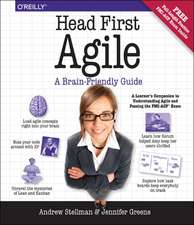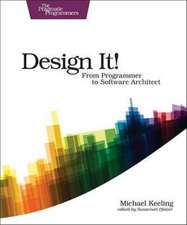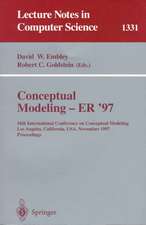Handbook of Conceptual Modeling: Theory, Practice, and Research Challenges
Editat de David W. Embley, Bernhard Thalheimen Limba Engleză Paperback – 13 oct 2014
Embley and Thalheim start with a manifesto stating that the dream of developing information systems strictly by conceptual modeling – as expressed in the phrase “the model is the code” – is becoming reality. The subsequent contributions written by leading researchers in the field support the manifesto's assertions, showing not only how to abstractly model complex information systems but also how to formalize abstract specifications in ways that let developers complete programming tasks within the conceptual model itself. They are grouped into sections on programming with conceptual models, structure modeling, process modeling, user interface modeling, and special challenge areas such as conceptual geometric modeling, information integration, and biological conceptual modeling.
The Handbook of Conceptual Modeling collects in a single volume many of the best conceptual-modeling ideas, techniques, and practices as well as the challenges that drive research in the field. Thus it is much more than a traditional handbook for advanced professionals, as it also provides both a firm foundation for the field of conceptual modeling, and points researchers and graduate students towards interesting challenges and paths for how to contribute to this fundamental field of computer science.
| Toate formatele și edițiile | Preț | Express |
|---|---|---|
| Paperback (1) | 1002.52 lei 6-8 săpt. | |
| Springer Berlin, Heidelberg – 13 oct 2014 | 1002.52 lei 6-8 săpt. | |
| Hardback (1) | 1008.95 lei 6-8 săpt. | |
| Springer Berlin, Heidelberg – 14 mar 2011 | 1008.95 lei 6-8 săpt. |
Preț: 1002.52 lei
Preț vechi: 1253.14 lei
-20% Nou
Puncte Express: 1504
Preț estimativ în valută:
191.86€ • 199.56$ • 158.39£
191.86€ • 199.56$ • 158.39£
Carte tipărită la comandă
Livrare economică 14-28 aprilie
Preluare comenzi: 021 569.72.76
Specificații
ISBN-13: 9783642430497
ISBN-10: 364243049X
Pagini: 612
Ilustrații: XIX, 589 p.
Dimensiuni: 155 x 235 x 32 mm
Greutate: 0.84 kg
Ediția:2011
Editura: Springer Berlin, Heidelberg
Colecția Springer
Locul publicării:Berlin, Heidelberg, Germany
ISBN-10: 364243049X
Pagini: 612
Ilustrații: XIX, 589 p.
Dimensiuni: 155 x 235 x 32 mm
Greutate: 0.84 kg
Ediția:2011
Editura: Springer Berlin, Heidelberg
Colecția Springer
Locul publicării:Berlin, Heidelberg, Germany
Public țintă
ResearchCuprins
Section I: Programming with Conceptual Models.- Chapter 1: Conceptual-Model Programming: A Manifesto.- Chapter 2: Model-Driven Software Development.- Section II: Structure Modeling.- Chapter 3: The Entity-Relationship Model—Toward a Unified View of Data.- Chapter 4: UML and OCL in Conceptual Modeling.- Chapter 5: Mapping Conceptual Models to Database Schemas.- Chapter 6: The Enhanced Entity-Relationship Model.- Section III: Process Modeling.- Chapter 7: Object-Process Methodology for Structure-Behavior Co-Design.- Chapter 8: Business Process Modelling and Workflow Design.- Chapter 9: BPMN Core Modeling Concepts: Inheritance-Based Execution Semantics.- Chapter 10: Conceptual Modelling of Interaction.- Chapter 11: Conceptual Modelling of Application Stories.- Section V: Special Challenge Areas.- Chapter 12: Evolution and Migration of Information Systems.- Chapter 13: Conceptual Geometric Modelling.- Chapter 14: Data Integration.- Chapter 15: Conceptual Modeling Foundations for a Web of Knowledge.- Chapter 16: A Conceptual Modeling Approach to Improve Human Genome Understanding.- Chapter 17: The Theory of Conceptual Models, the Theory of Conceptual Modelling and Foundations of Conceptual Modelling.
Textul de pe ultima copertă
Conceptual modeling is about describing the semantics of software applications at a high level of abstraction in terms of structure, behavior, and user interaction.
Embley and Thalheim start with a manifesto stating that the dream of developing information systems strictly by conceptual modeling – as expressed in the phrase “the model is the code” – is becoming reality. The subsequent contributions written by leading researchers in the field support the manifesto's assertions, showing not only how to abstractly model complex information systems but also how to formalize abstract specifications in ways that let developers complete programming tasks within the conceptual model itself. They are grouped into sections on programming with conceptual models, structure modeling, process modeling, user interface modeling, and special challenge areas such as conceptual geometric modeling, information integration, and biological conceptual modeling.
The Handbook of Conceptual Modeling collects in a single volume many of the best conceptual-modeling ideas, techniques, and practices as well as the challenges that drive research in the field. Thus it is much more than a traditional handbook for advanced professionals, as it also provides both a firm foundation for the field of conceptual modeling, and points researchers and graduate students towards interesting challenges and paths for how to contribute to this fundamental field of computer science.
Embley and Thalheim start with a manifesto stating that the dream of developing information systems strictly by conceptual modeling – as expressed in the phrase “the model is the code” – is becoming reality. The subsequent contributions written by leading researchers in the field support the manifesto's assertions, showing not only how to abstractly model complex information systems but also how to formalize abstract specifications in ways that let developers complete programming tasks within the conceptual model itself. They are grouped into sections on programming with conceptual models, structure modeling, process modeling, user interface modeling, and special challenge areas such as conceptual geometric modeling, information integration, and biological conceptual modeling.
The Handbook of Conceptual Modeling collects in a single volume many of the best conceptual-modeling ideas, techniques, and practices as well as the challenges that drive research in the field. Thus it is much more than a traditional handbook for advanced professionals, as it also provides both a firm foundation for the field of conceptual modeling, and points researchers and graduate students towards interesting challenges and paths for how to contribute to this fundamental field of computer science.
Caracteristici
Collects the best conceptual modeling ideas, techniques and practices
Points researchers to interesting challenges in theory and practice
Includes applications in novel areas like spatial and bioinformatics modeling and information integration
May serve as a comprehensive textbook for graduate courses
Includes supplementary material: sn.pub/extras
Points researchers to interesting challenges in theory and practice
Includes applications in novel areas like spatial and bioinformatics modeling and information integration
May serve as a comprehensive textbook for graduate courses
Includes supplementary material: sn.pub/extras


























